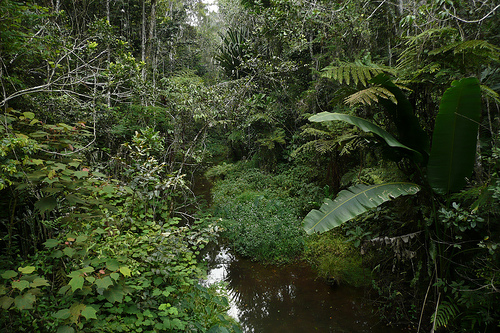

Location: Map
Area: 155 sq km
The Perinet Rainforest, also known as Andasibe-Mantadia National Park, is a biodiversity hotspot in eastern Madagascar, roughly 140 km east of Antananarivo. Spanning about 15,500 hectares, it encompasses primary and secondary rainforest ecosystems, characterized by dense, humid forests, wetlands, and mountainous terrain ranging from 800 to 1,260 meters in elevation. The park is divided into two main areas: the smaller Analamazaotra Reserve (often called Perinet) and the larger Mantadia National Park, each offering distinct ecological features.
The region experiences a tropical humid climate with annual rainfall between 1,500 and 2,000 mm, peaking during the rainy season (November to March). Temperatures average 18-25°C, with cooler nights at higher elevations. The landscape is marked by rolling hills, fast-flowing streams, and waterfalls, with lateritic (iron-rich) soils typical of Madagascar’s eastern escarpment. The forest canopy reaches 20-30 meters, creating a multilayered habitat of epiphytes, lianas, and towering hardwoods like rosewood and ebony.
The Perinet Rainforest hosts over 1,000 plant species, with 80%
endemic to Madagascar. Notable are:
Orchids: Over 100
species, including the vibrant Angraecum sesquipedale,
pollinated by the long-tongued hawk moth.
Hardwoods: Precious
woods like Dalbergia (rosewood) and Diospyros (ebony), though
logging threats persist.
Medicinal Plants: Species like Catha
edulis are used locally for their stimulant properties.
Epiphytes and Ferns: Bromeliads, mosses, and tree ferns thrive
in the humid understory.
The forest’s primary growth areas
are dense, while secondary forests, recovering from past
logging, show sparser canopies but rapid regeneration.
Perinet is renowned for its exceptional wildlife, particularly
lemurs, with 11 species recorded:
Indri (Indri indri):
The largest living lemur, known for its haunting, whale-like
calls audible over 2 km. It’s a diurnal, tree-dwelling primate
feeding on leaves and fruits.
Diademed Sifaka (Propithecus
diadema): A colorful, acrobatic lemur with a distinctive
white-and-orange coat.
Common Brown Lemur (Eulemur fulvus)
and Red-bellied Lemur (Eulemur rubriventer): Social species
often seen in mixed troops.
Other mammals include the endemic
eastern woolly lemur and the elusive aye-aye, a nocturnal lemur
with specialized fingers for foraging grubs.
Birdlife:
Over 100 bird species, 70% endemic, inhabit the park. Highlights
include the Madagascar crested ibis, blue coua, and velvet
asity. The forest’s understory is a haven for ground-dwelling
species like the scaly ground roller.
Reptiles and
Amphibians: Perinet hosts 50 reptile and 80 frog species. The
Parson’s chameleon (Calumma parsonii), one of the largest
chameleons, and the tiny Brookesia leaf chameleons are iconic.
Frogs like the golden mantella (Mantella aurantiaca) add vibrant
color to the forest floor.
Invertebrates: Thousands of
insect species, including the comet moth (Argema mittrei) with
its 20-cm wingspan, and endemic spiders like the Darwin’s bark
spider, known for weaving the strongest webs in the world.
The rainforest plays a critical role in Madagascar’s ecosystem, acting as a watershed for local rivers and a carbon sink. Its isolation over millions of years has driven unique evolutionary paths, making it a living laboratory for studying endemism. The park’s biodiversity supports ecotourism, a vital economic driver for nearby communities like Andasibe village.
Perinet faces significant threats:
Deforestation: Historical
logging and slash-and-burn agriculture (tavy) have reduced
forest cover. Secondary forests are recovering, but primary
forest loss is irreversible.
Illegal Logging: Rosewood and
ebony smuggling persists despite bans.
Habitat Fragmentation:
Roads and agriculture isolate wildlife populations, threatening
genetic diversity.
Climate Change: Altered rainfall patterns
and temperature shifts impact amphibian breeding and plant
phenology.
Conservation efforts, led by organizations like
Madagascar National Parks and NGOs such as Mitsinjo, focus on
reforestation, community education, and anti-poaching patrols.
Ecotourism revenue funds these initiatives, but political
instability and poverty complicate enforcement.
The park offers guided day and night hikes, with trails like the Indri Trail (Analamazaotra) and Tsarafrara Circuit (Mantadia) showcasing lemurs, birds, and waterfalls. The Vakona Forest Lodge’s private reserve, nearby, provides close encounters with habituated lemurs. Night walks reveal nocturnal species like mouse lemurs and chameleons. Visitors should prepare for muddy trails in the rainy season and leeches, but the biodiversity rewards outweigh the challenges.
The local Betsimisaraka and Merina communities view the forest as sacred, with taboos (fady) protecting species like the indri, believed to be ancestral spirits. Community-based ecotourism projects, like those run by Mitsinjo, integrate cultural heritage with conservation, offering insights into Malagasy traditions.